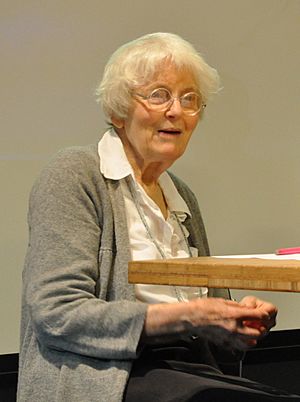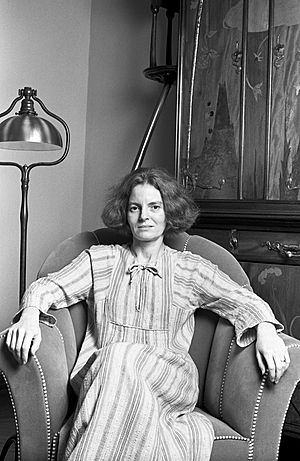Denise Scott Brown facts for kids
Quick facts for kids
Denise Scott Brown
|
|
|---|---|

Scott Brown in October 2012
|
|
| Born |
Denise Lakofski
October 3, 1931 Nkana, Northern Rhodesia (now Zambia)
|
| Nationality | South African |
| Alma mater | University of the Witwatersrand Architectural Association School of Architecture University of Pennsylvania |
| Occupation | Architect |
| Spouse(s) | |
| Parent(s) | Simon Lakofski Phyllis Hepker |
| Practice | Venturi, Scott Brown and Associates Venturi and Rauch Venturi, Rauch and Scott Brown |
Denise Scott Brown (born October 3, 1931) is an American architect, city planner, writer, and teacher. She is a main leader at the architecture firm Venturi, Scott Brown and Associates in Philadelphia.
Contents
Early Life and Education
Denise Lakofski was born on October 3, 1931, to Simon and Phyllis Lakofski. From a young age, she knew she wanted to be an architect. She spent her summers working with architects to learn more.
From 1948 to 1952, she studied at the University of the Witwatersrand in South Africa. She also briefly got involved in politics. However, she found it hard for women to be accepted in that field.
In 1952, Denise moved to London. She worked for a modern architect named Frederick Gibberd. She continued her studies at the Architectural Association School of Architecture. She wanted to learn skills to help build a fair South Africa. In 1954, she met Robert Scott Brown, and they both studied there. She earned her architecture degree in 1955.
Denise Lakofski and Robert Scott Brown married on July 21, 1955. For the next three years, they worked and traveled across Europe. They visited Italy with their friend, Robin Middleton, who studied architecture history.
In 1958, they moved to Philadelphia to study city planning at the University of Pennsylvania. Sadly, in 1959, Robert passed away in a car accident. Denise finished her special degree in city planning in 1960. After graduating, she became a teacher at the university.
Her Career in Architecture
Teaching and Research
While teaching, Denise Scott Brown also earned another special degree in architecture. In 1960, she spoke up against tearing down the university's library. This library, now called the Fisher Fine Arts Library, was designed by Frank Furness. At that meeting, she met Robert Venturi, another young architect and teacher.
Denise and Robert started working together and taught classes from 1962 to 1964. Denise Scott Brown left the University of Pennsylvania in 1965. She became an expert in city planning. She taught at the University of California, Berkeley. Later, she became a co-leader of the Urban Design Program at the University of California, Los Angeles.
During her time in the Southwest, Scott Brown became very interested in newer cities like Los Angeles and Las Vegas. She invited Robert Venturi to visit her classes. In 1966, she asked him to visit Las Vegas with her. They married in Santa Monica, California, on July 23, 1967. Scott Brown moved back to Philadelphia in 1967 to join Robert Venturi's firm, Venturi and Rauch. By 1969, she became the main person in charge of planning there.
Scott Brown later taught at Yale University. She created courses that taught architects to look at city problems using science, media, and pop culture ideas. In 2003, she was a visiting teacher with Venturi at Harvard University's Graduate School of Design.
Important Books and Ideas
In 1972, Scott Brown, Venturi, and Steven Izenour wrote a book called Learning From Las Vegas: the Forgotten Symbolism of Architectural Form. This book shared studies of the Las Vegas Strip. These studies were done with students in a special architecture class Scott Brown taught with Venturi at Yale in 1970. The book introduced terms like "Duck" and "Decorated Shed" to describe different building styles.
This book, along with Venturi's earlier book Complexity and Contradiction in Architecture, challenged old ideas about modern architecture. They showed how American cities and everyday buildings could be interesting. Scott Brown has continued to write about architecture and city planning.
Scott Brown and Venturi wanted to understand cities by looking at their social, economic, and cultural sides. They saw cities as complex systems. Their firm, Venturi, Scott Brown & Associates, studies trends in an area. They look at how populations move and daily routines. This helps them create plans and designs. For example, for their Berlin Tomorrow Competition, they thought about how people move and live each day. For the Bryn Mawr College plan, they considered the old buildings and how campus spaces were used.
Scott Brown uses a step-by-step way of planning called "FFF studios." This means that form, forces, and function help define the city environment. For instance, their firm studied how the Dartmouth College campus was growing. They also looked at the wild areas around it.
Working with the Firm
The firm was renamed Venturi, Rauch and Scott Brown in 1980. Then, it became Venturi, Scott Brown and Associates in 1989. Scott Brown has led many city planning projects and studies. More recently, she has guided planning projects for university campuses. By the early 1980s, experts saw them as very important and creative architects. They continued their work with clear ideas and new design theories.
She also worked as a main leader with Robert Venturi on the firm's bigger building projects. These include the Sainsbury Wing of London's National Gallery, a government building in Toulouse, France, and the Nikko Hotel and Spa Resort in Japan.
Learning From Pop Culture
In 1973, Denise Scott Brown wrote an essay called "Learning From Pop." In it, she said it was important to think about pop culture when designing buildings. This added a symbolic side to architecture. It meant using ideas from the time, like colors and signs in buildings. This idea was very similar to the "Learning From Las Vegas" book.
Speaking Up for Women
In 1989, Scott Brown published her famous essay, "Room at the Top? Sexism and the Star System in Architecture." She actually wrote this essay in 1975 but waited to publish it. She was worried it might hurt her career. The essay talks about her struggle to be seen as an equal partner in her firm. The world of architecture was mostly male at that time. Since then, she has been a strong supporter of women in architecture. She has spoken out many times about unfair treatment in the profession.
Architecture Projects
- Undergraduate Science Building, Life Sciences Institute and Palmer Commons complex University of Michigan; Ann Arbor, Michigan (2005)
- Brown University Campus Life Plan; Providence, Rhode Island (2004)
- Tsinghua University Campus Plan Suggestions; Beijing, China (2004)
- Baker-Berry Library, Dartmouth College; Hanover, New Hampshire (2002)
- Radcliffe Institute for Advanced Study at Harvard University Campus Plan; Boston, Massachusetts (2002)
- Williams College Campus Plan; Williamstown, Massachusetts (2001)
- Frist Campus Center, Princeton University; New Jersey (2000)
- Rauner Special Collections Library, Dartmouth College; Hanover, New Hampshire (2000)
- Perelman Quadrangle, University of Pennsylvania; Philadelphia (2000)
- Seat of the departmental council; Toulouse, France (1999)
- Gonda (Goldschmied) Neurosciences and Genetics Research Center, UCLA; Los Angeles, California (1998)
- University of Michigan Campus Plan; Ann Arbor, Michigan (1997–2005)
- Bryn Mawr College Campus Plan; Bryn Mawr, Pennsylvania (1997)
- Mielparque Nikko Kirifuri Resort; Nikko National Park, Japan (1997)
- Museum of Contemporary Art, San Diego; La Jolla, California (1996)
- Denver Civic Center Plan; Denver, Colorado (1995)
- Charles P. Stevenson, Jr. Library, Bard College; Annandale-on-Hudson, New York (1994)
- Children's Museum; Houston, Texas (1992)
- Sainsbury Wing, National Gallery, London; United Kingdom (1991)
- Seattle Art Museum; Seattle, Washington (1991)
- Restoration of the Fisher Fine Arts Library, University of Pennsylvania; Philadelphia (1991)
- University of Pennsylvania Campus Planning; Philadelphia (1988–2000)
- Center City Development Plan; Memphis, Tennessee (1987)
- Lewis Thomas Laboratory; Princeton University, New Jersey (1986)
- Gordon Wu Hall; Princeton University, New Jersey (1983)
- Hennepin Avenue Transit/Entertainment Study; Minneapolis, Minnesota (1981)
- Jim Thorpe Historic District Planning Study; Jim Thorpe, Pennsylvania (1979)
- Washington Avenue Revitalization Plan; Miami Beach, Florida (1978)
- Best Products Catalog Showroom; Langhorne, Pennsylvania, (1978)
- Allen Memorial Art Museum, Oberlin College; Oberlin, Ohio (1976)
- Basco Showroom; Philadelphia (1976)
- Franklin Court; Philadelphia (1976)
- South Street "Crosstown Community" Planning; Philadelphia (1970)
- Shanghai High-rise skyscraper office towers; Shanghai, China (2003)
- U.S. Embassy Competition for U.S. Embassy in Berlin; Berlin (1995)
Awards and Recognition
Denise Scott Brown has received many awards for her work:
- Lifetime Achievement Award at Lisbon Architecture Triennale
- Soane Medal; 2018
- Jane Drew Prize; 2017
- European Cultural Centre Architecture Award; 2016
- AIA Gold Medal; 2016 (with Robert Venturi)
- Edmund N. Bacon Prize, Philadelphia Center for Architecture; 2010
- Design Mind Award, Cooper-Hewitt National Design Awards, 2007 (with Robert Venturi)
- Athena Medal, Congress for the New Urbanism, 2007
- Vilcek Prize in Architecture, The Vilcek Foundation, 2007
- Membership, American Philosophical Society, 2006
- The Carpenters' Company Master Builder Award; 2005
- Harvard Radcliffe Institute Medal; 2005
- Visionary Woman Award, Moore College of Art & Design; 2003
- Vincent Scully Prize, National Building Museum, 2002, with Robert Venturi
- Topaz Medallion, American Institute of Architects, 1996
- National Medal of Arts, United States Presidential Award, 1992 (with Robert Venturi)
- Chicago Architecture Award, 1987
- ACSA (Association of Collegiate Schools of Architecture) Distinguished Professor Award, 1986-87
- AIA Firm Award, to Venturi, Rauch and Scott Brown; 1985
She is also one of four female architects featured in the 2018 documentary film City Dreamers.
Published Works
- Learning from Las Vegas: the Forgotten Symbolism of Architectural Form, (with Robert Venturi and Steven Izenour), 1972; revised edition 1977. ISBN: 0-262-72006-X
- Denise Scott Brown, Learning from Pop, 1973.
- A View from the Campidoglio: Selected Essays, 1953–1984, (with Robert Venturi), 1984. ISBN: 0-06-438851-4
- Urban Concepts, Architectural Design Profile 60: January–February 1990. ISBN: 0-85670-955-7
- Denise Scott Brown, Room at the top? Sexism and the Star System in Architecture, 1989, in: RENDELL, J., PENNER, B. and BORDEN, I. (ed.): Gender Space Architecture. An Interdisciplinary Introduction, Routhledge, New York, 2000, p 258-265
- Architecture as Signs and Systems: for a Mannerist Time (with Robert Venturi), 2004. ISBN: 0-674-01571-1
- The art in waste (article), In:Distoriones urbanas / Urban Distorisions, Madrid: Basurama, 2006. ISBN: 978-84-95321-85-5
- On Public Interior Space (with Maurice Harteveld), In: AA Files 56, London: Architectural Association Publications, 2007.
- Denise Scott Brown, Having Words (London: Architectural Association, 2009)
See also
 In Spanish: Denise Scott Brown para niños
In Spanish: Denise Scott Brown para niños


